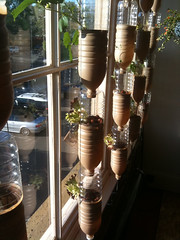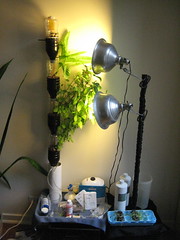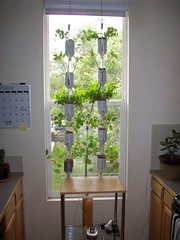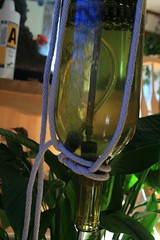 |
| Golden sage has vibrant colours and a delicate albeit elaborate pattern. |
Hélène:
I love sage. The odor is divine, it's got - from one variety to the next - a colour palette that makes my heart sing and the texture of its leaves is so intricate I like to rub a leaf between my fingers once in a while when I garden.
 |
| A wonderful spring surprise, the sage is coming back, at the same time as tulips. |
Autumn comes knocking on our doors soon enough however and I become sad about it. I realise I didn't use sage once this summer and I will soon loose a plant that is still bulky with aromatic leaves. You may think a rose is ephemeral, but for me sage is even more since I didn't use it as I should have.
Last Fall however, I read that sage was a perennial that lived down to zone 5. What? It's not an annual? Even thought the purple and gold variety have the reputation of being more fragile against cold than the standard green-leaves variety (salvia officinalis), here's something I didn't know at all. At the nursery, sage is sold with other annual herbs, so I naively believed it was an annual too. If you live in the greater Montreal region, you may just be able to grow sage for many years instead of buying a new plant every spring. For the winter preparation, I just made sure not to cut all the leaves of my plant as a fall harvest and covered it with a thick layer of dead leaves.
Bonus! I also made a great discovery in the kitchen after I had dried my purple sage leaves (my favorite). I dry them whole (the aroma keeps better than if I had cut it, in my experience and what I could find on the internet) and once dried, they are a cinch to reduce in powder form! A wisk of my mortar and pestle renders them thus and perfume my kitchen beautifully at the same time. I love to use this herb when roasting an entire chicken or in a soup! But there are many recipes out there, it's classically use on veal, for example saltimbocca, an italian meal.
Here's a very interesting article on medicinal and culinary use of sage (it's in French, however). But here's another one in English. It contains very interesting informations about culinary uses.
Sage is one of the oldest plants recognized for its medicinal properties, going back to the Greeks and even the Egyptians. It is used to gargarize against sore throat or canker sore, as a remedy against certain types of infections and more. The array of things it can apparently cure is wide (there's this french article that enumerates a bunch of them. For medicinal information in English, you may take a look here.). It was also used by the first nations to drive away evil spirits when it was burned.
Althought I don't personally use it medicinally, I find it a stellar beauty to bulk up a container!
Louise :
Sage blossoms are appreciated by bees and other pollinators. Humans can also appreciate the flowers by adding them to salads. And it is also possible to overwinter sage in zone 4 with the help of a thick mulch and a good cover of snow.
Sage is also called the sacred herb and Europe's Tea. It's indeed possible to make a very good herbal tea that as a wide range of medicinal properties. Finally, there's this provençal proverb : "Qui a de la sauge dans un jardin n'a pas besoin d'un médecin", stating that "If you have sage in the garden, you don't need a doctor."
 |
| In August, the sage in my containers is a superb sight. In the tiny glass jar next to it, there's the vibrant yellow flowers of my Mullein harvest, destined to be used in the fabrication of mullein oil against earaches. |















































